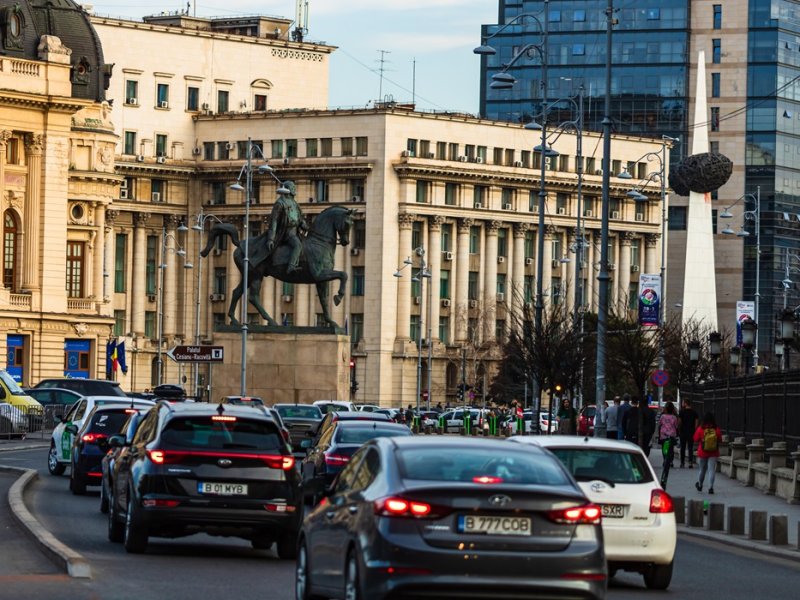Which are the most congested areas in Bucharest in 2025? It's one of the most crowded capitals in Europe.

By Bucharest Team
- NEWS
- 23 JUL 25
Bucharest ranks among the most congested cities in the world
In 2025, Bucharest remains one of the world’s most congested cities, according to the latest data from the TomTom Traffic Index. Romania’s capital holds the 8th place globally and 4th in Europe in the ranking of cities with the worst traffic. Urban traffic in Bucharest has steadily worsened in recent years, with residents spending more and more time in gridlock — significantly affecting both quality of life and the local economy.
In 2023 alone, Bucharest drivers lost an average of 150 hours stuck in traffic during rush hour. The average driving speed during peak times dropped to around 17 km/h. The worst traffic day of the year was November 28, when it took over 36 minutes to travel just 10 kilometers.
Compared to 2022, the average time to drive 10 km increased by 20 seconds, reaching 27 minutes and 40 seconds. According to TomTom, traffic congestion reached 55%, which translates to considerable economic losses for both individual drivers and businesses.
Piața Romană, Piața Victoriei, and the Jewish Quarter: Bucharest’s worst traffic hotspots
According to the T.R.A.I. index (Traffic, Landmarks, Air, and Real Estate) by the platform Storia, the city’s most congested neighborhoods are Piața Romană, the Jewish Quarter, the Old Town, and Piața Victoriei. These areas are notorious for constant gridlock and wasted time behind the wheel. Piața Romană scored 0 out of 100, indicating extremely high congestion. The Jewish Quarter received just 3 points, and Piața Victoriei only 4.3.
On the flip side, the least congested areas include Băneasa Forest, Uranus, and Primăverii district, where traffic is considerably smoother. Băneasa Forest, for example, scored 72.8, making it one of the most “breathable” traffic zones in the city.
Separate INRIX Research studies confirm that Bucharest drivers lose around 100 hours per year in traffic — the equivalent of four full days spent idling at traffic lights or in lines of cars.
A0 Ring Motorway: A partial solution to avoid Bucharest’s urban traffic
A partial solution to Bucharest’s notorious traffic is the A0 motorway, the city’s outer ring road. As of 2025, the southern segment of the A0 is completed, with Lot 3 (18 km) soon to open. This section connects the A1 Motorway (Bucharest–Pitești) with the A2 (Sun Motorway to Constanța) and is essential for bypassing the urban area.
The lot, built by a Greek construction company, faced repeated delays and missed deadlines, which now may lead to contractual penalties. This stretch includes bridges, overpasses (including one over A1 near Ciorogârla), service areas, and short-term parking.
Once open, Lot 3 will complete the 51-kilometer southern section of the A0, allowing drivers to completely bypass southern Bucharest. It’s particularly good news for truck drivers and logistics companies, who will finally be able to avoid the gridlocked intersections on the current ring road.
Heavy traffic redirected out of the city
Another major benefit of the A0 is the diversion of heavy vehicles — especially trucks traveling from central Romania to Constanța or border checkpoints. These vehicles currently add significantly to Bucharest’s congestion. The A0 provides a faster, safer, and more efficient alternative.
The infrastructure is also vital for the business districts around Bucharest, where many companies have logistics centers and warehouses. Frequent traffic jams on the current ring road impact delivery times and operational efficiency. A completed southern bypass could reduce those delays considerably.
However, construction on the northern segment of A0 is still ongoing. While authorities hope some sections will open ahead of schedule, the entire ring road is expected to be ready within the next two years. Until then, residents will have to endure the city’s chronic congestion.
Soaring car numbers, but slow solutions
A core cause of traffic is the sharp increase in the number of vehicles. Over the past decade, more than 560,000 new vehicles have been registered in Bucharest and Ilfov, according to the Directorate for Driving Licenses and Vehicle Registration. In Bucharest alone, that’s a 30% increase, while in Ilfov, the number of cars has tripled.
As of 2022, Bucharest had over 1.5 million registered vehicles. However, the city’s road infrastructure hasn’t kept pace with this explosion in car ownership. Lack of parking, inefficient intersections, and an underdeveloped public transport system only make things worse.
Without integrated measures — such as modernizing public transport, encouraging alternative mobility, and adopting smart urban planning — Bucharest risks becoming permanently trapped in its own traffic. The A0 helps, but it’s no silver bullet.


























